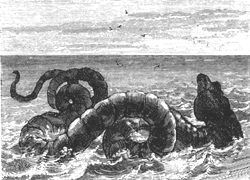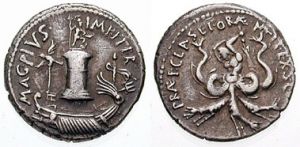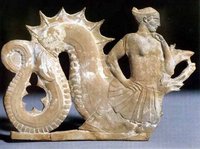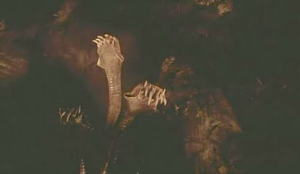| Line 1: | Line 1: | ||
[[Category:Mythological Creatures]] | [[Category:Mythological Creatures]] | ||
[[Image:Scylla.jpg|frame|Scylla]] | [[Image:Scylla.jpg|frame|Scylla]] | ||
In [[Greek mythology]], '''Scylla''', or '''Skylla''' (Greek Σκύλλα) was a name shared by two characters, a female [[sea]] [[monster]] and a [[scylla (princess)|princess]]. | |||
[[Image:Denarius Sextus Pompeius-Scilla.jpg|thumb|[[Sextus Pompeius]] [[denarius]], depicting the Pharus of [[Messina]] and Scylla.]] | |||
'''Scylla''' is one of the two [[sea monster]]s in [[Greek mythology]] (the other being [[Charybdis]]) which lives on one side of a narrow channel of water. The two sides of the strait are within an arrow's range of each other, so close that sailors attempting to avoid Charybdis will pass too close to Scylla and vice versa. The phrase ''between Scylla and Charybdis'' has come to mean being in a state where one is between two dangers and moving away from one will cause you to be in danger from the other. Traditionally the aforementioned strait has been associated with the [[Strait of Messina]] between [[Italy]] and [[Sicily]] but more recently this theory has been challenged and the alternative location of [[Cape Skilla]] in north west Greece suggested. Scylla is a horribly grotesque sea monster, with six long necks equipped with grisly heads, each of which contained three rows of sharp teeth. Her body consisted of twelve canine legs and a fish's tail. She was one of the children of [[Phorcys]] and either [[Hecate]], [[Crataeis]], [[Lamia]] or [[Ceto]] (where Scylla would also be known as one of the [[Phorcydes]]). | |||
[[Image:Scylla2.jpg|left|thumb|200px|Scylla carving from Milos, 5th century BC, British Museum, London]] | |||
In [[Homer]]'s ''[[Odyssey]]'', [[Odysseus]] is given advice by [[Circe]] to sail closer to Scylla, for Charybdis could drown his whole ship. Odysseus then successfully navigates his ship past Scylla and Charybdis, but Scylla manages to catch six of his men, devouring them alive. | |||
Scylla was a nymph, daughter of Phorcys. The fisherman-turned-sea-[[god]] Glaucus fell madly in love with her, but she fled from him onto the land where he could not follow. Despair filled his heart. He went to the sorceress Circe to ask for a love potion to melt Scylla's heart. As he told his tale of love to Circe, she herself fell in love with him. She wooed him with her sweetest words and looks, but the sea-god would have none of her. Circe was furiously angry, but with Scylla and not with Glaucus. She prepared a vial of very powerful poison and poured it in the pool where Scylla bathed. As soon as the nymph entered the water she was transformed into a frightful monster with twelve feet and six heads, each with three rows of [[teeth]]. She stood there in utter misery, unable to move, loathing and destroying everything that came into her reach, a peril to all [[sailors]] who passed near her. Whenever a ship passed, each of her heads would seize one of the crew. | |||
As retold by [[Thomas Bulfinch]], Scylla was originally a beautiful [[nymph]]. She scorned her many suitors and chose to live among the [[Nereids]] instead, until one day [[Glaucus]] saw and fell in love with her. Glaucus was a mortal fisherman who had previously been transformed by chewing a plant, gaining the form of a fish from his waist down. When Glaucus declared his love to Scylla she fled, taking him for a monster. Glaucus sought the help of [[Circe]], hoping that this witch could make Scylla to love him with her herbs, but Circe fell in love with Glaucus herself and asked him to forget Scylla. Glaucus rejected her request, declaring that his love for Scylla was eternal. | |||
[[Image:Scylla_1997.png|thumb|300px|Three of Scylla's heads as portrayed in ''The Odyssey (1997)'' TV miniseries; the film depicts each head striking with snake-like speed and accuracy and devouring men whole.]] | |||
Circe was enraged by Glaucus' refusal, and turned her anger on the girl whom he loved. She went and poisoned the water which Scylla used to bathe with her magical herbs. When Scylla waded into the water, six dogs' heads emerged from her torso, devouring anyone who came near her, beyond her control. Scylla fled to the shore of the strait to live there alone in misery. | |||
It is said that by the time [[Aeneas]]' fleet came through the strait after the fall of [[Troy]], Scylla had been changed into a dangerous rock outcropping which still stands there to this day. | |||
Scylla and Charybdis are believed to have been the entities from which the term, "Between a rock and a hard place" (ie: a difficult place) originated. | |||
It has been suggested that the myth of Scylla may have been inspired by real life encounters with [[giant squid]] (which are normally dying when near the surface), and she has some similar features to the [[kraken]] in [[Norse mythology]] and [[lusca]] in [[Caribbean]] mythology. | |||
==External links== | |||
[[Category:Mythological Creatures]] | |||
Revision as of 00:30, 29 May 2006
In Greek mythology, Scylla, or Skylla (Greek Σκύλλα) was a name shared by two characters, a female sea monster and a princess.
Scylla is one of the two sea monsters in Greek mythology (the other being Charybdis) which lives on one side of a narrow channel of water. The two sides of the strait are within an arrow's range of each other, so close that sailors attempting to avoid Charybdis will pass too close to Scylla and vice versa. The phrase between Scylla and Charybdis has come to mean being in a state where one is between two dangers and moving away from one will cause you to be in danger from the other. Traditionally the aforementioned strait has been associated with the Strait of Messina between Italy and Sicily but more recently this theory has been challenged and the alternative location of Cape Skilla in north west Greece suggested. Scylla is a horribly grotesque sea monster, with six long necks equipped with grisly heads, each of which contained three rows of sharp teeth. Her body consisted of twelve canine legs and a fish's tail. She was one of the children of Phorcys and either Hecate, Crataeis, Lamia or Ceto (where Scylla would also be known as one of the Phorcydes).
In Homer's Odyssey, Odysseus is given advice by Circe to sail closer to Scylla, for Charybdis could drown his whole ship. Odysseus then successfully navigates his ship past Scylla and Charybdis, but Scylla manages to catch six of his men, devouring them alive.
Scylla was a nymph, daughter of Phorcys. The fisherman-turned-sea-god Glaucus fell madly in love with her, but she fled from him onto the land where he could not follow. Despair filled his heart. He went to the sorceress Circe to ask for a love potion to melt Scylla's heart. As he told his tale of love to Circe, she herself fell in love with him. She wooed him with her sweetest words and looks, but the sea-god would have none of her. Circe was furiously angry, but with Scylla and not with Glaucus. She prepared a vial of very powerful poison and poured it in the pool where Scylla bathed. As soon as the nymph entered the water she was transformed into a frightful monster with twelve feet and six heads, each with three rows of teeth. She stood there in utter misery, unable to move, loathing and destroying everything that came into her reach, a peril to all sailors who passed near her. Whenever a ship passed, each of her heads would seize one of the crew.
As retold by Thomas Bulfinch, Scylla was originally a beautiful nymph. She scorned her many suitors and chose to live among the Nereids instead, until one day Glaucus saw and fell in love with her. Glaucus was a mortal fisherman who had previously been transformed by chewing a plant, gaining the form of a fish from his waist down. When Glaucus declared his love to Scylla she fled, taking him for a monster. Glaucus sought the help of Circe, hoping that this witch could make Scylla to love him with her herbs, but Circe fell in love with Glaucus herself and asked him to forget Scylla. Glaucus rejected her request, declaring that his love for Scylla was eternal.
Circe was enraged by Glaucus' refusal, and turned her anger on the girl whom he loved. She went and poisoned the water which Scylla used to bathe with her magical herbs. When Scylla waded into the water, six dogs' heads emerged from her torso, devouring anyone who came near her, beyond her control. Scylla fled to the shore of the strait to live there alone in misery.
It is said that by the time Aeneas' fleet came through the strait after the fall of Troy, Scylla had been changed into a dangerous rock outcropping which still stands there to this day.
Scylla and Charybdis are believed to have been the entities from which the term, "Between a rock and a hard place" (ie: a difficult place) originated.
It has been suggested that the myth of Scylla may have been inspired by real life encounters with giant squid (which are normally dying when near the surface), and she has some similar features to the kraken in Norse mythology and lusca in Caribbean mythology.




